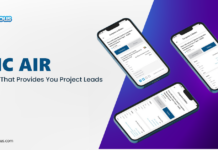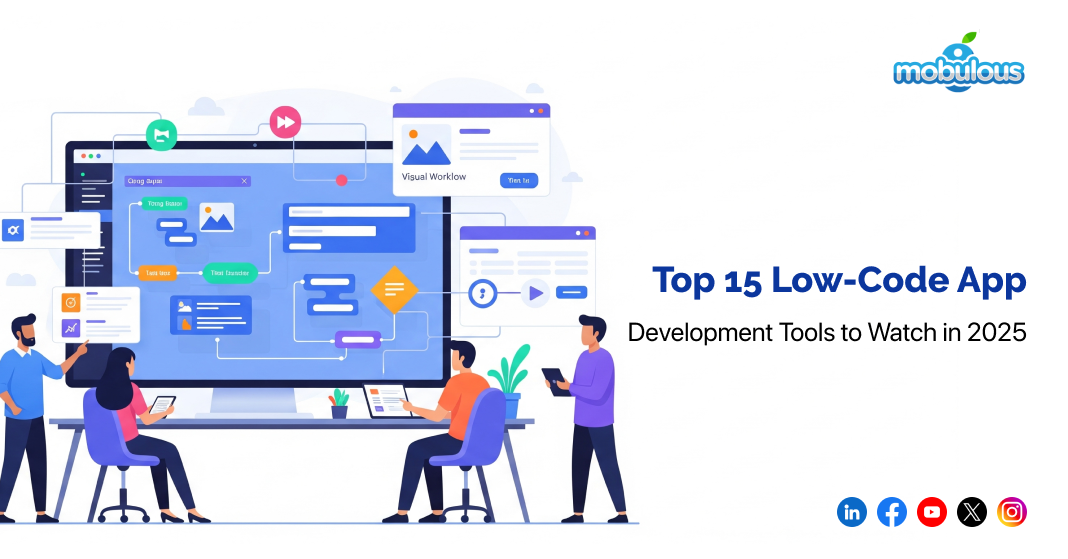What is a Low-Code App Development Tool?
A low-code app development tool lets you build software without writing much code. Instead of typing out code, you use drag-and-drop features. These platforms make development faster. They’re perfect for people who aren’t professional developers. Teams can work together easily and launch apps much quicker.
If you’re building smart devices or connected systems, consider exploring an IoT app development company that specializes in low-code platforms for IoT use cases.
List of Top 15 Low-Code App Development Tools
- OutSystems
- Mendix
- Appian
- Microsoft Power Platform
- Zoho Creator
- Bubble
- Quickbase
- GeneXus
- Kissflow
- Nintex
- Pegasystems (Pega)
- Creatio
- Xano
- Backendless
- Airtable
Top 15 Low-Code App Development Tools: Features, Pros, Cons & Pricing
General-Purpose App Development
- OutSystems
OutSystems is a powerful low-code app development tool. It’s built for businesses that want fast and scalable apps. You can create full-stack applications and update them in real time. It also connects well with other tools and services.
Features of OutSystems:
- Visual full-stack app builder
- Built-in performance tracking
- Continuous integration support
| Pros of OutSystems | Cons of OutSystems |
| Scales to enterprise | Learning curve high |
| Reliable support team | The price is steep |
| Good security model | Needs strong servers |
Best use case: Building complex enterprise-grade systems
Pricing: Starts at $2,100/month
- Mendix
Mendix is a flexible low-code app development tool. It works well for both developers and business users. You can prototype quickly, test in real time, and deploy to multiple platforms.
Features:
- AI-guided development process
- Deploy to any cloud
- Mobile and desktop support
| Pros | Cons |
| Fast prototyping possible | Offline mode weak |
| Friendly user interface | Cost rises fast |
| Helpful community forum | Takes time to master |
Best use case: Enterprise apps with flexible teams
Pricing: Starts at $75/month
- Appian
Appian mixes low-code development with automation. It’s a low-code app development tool that helps companies work faster. You can use it to automate tasks and make smarter decisions.
Features of Appian:
- Workflow automation tools
- AI and machine learning
- One interface for all roles
| Pros of Appian | Cons of Appian |
| Speeds up workflows | Basic UI options |
| Useful automation tools | Expensive to start |
| Secure and compliant | Complex for beginners |
Best use case: Automating business workflows
Pricing: Starts at $75/user/month
- Microsoft Power Platform
Power Platform is a low-code app development tool made by Microsoft. It includes Power Apps, Power Automate, and more. It’s great for those already using Microsoft products.
Features:
- Works with Office 365
- Build bots with no code
- Visual analytics included
| Pros | Cons |
| Microsoft-friendly system | Tied to the Microsoft stack |
| Connects with many tools | Not for complex apps |
| Lots of learning resources | Slower with large data |
Best use case: Internal tools for Microsoft-based teams
Pricing: Starts at $20/user/month
- Zoho Creator
Zoho Creator is an affordable, low-code app development tool. It’s ideal for small businesses. You can build and deploy apps quickly. It also connects easily with Zoho’s other tools.
Features of Zoho Creator:
- Drag-and-drop UI builder
- Built-in analytics system
- Secure user permissions
| Pros of Zoho Creator | Cons of Zoho Creator |
| Budget-friendly pricing | UI feels outdated |
| Quick to get started | Not ideal for scaling |
| Part of the Zoho suite | Few design options |
Best use case: Apps for small business processes
Pricing: Starts at $8/user/month
- Bubble
Bubble helps you build apps without writing code. It’s a front-end-focused low-code app development tool. It’s perfect for creating web apps or testing ideas fast.
Features:
- Full design control
- Backend included
- Plugin store available
| Pros | Cons |
| No code needed | Scaling gets pricey |
| Great for MVPs | Mobile support lacking |
| Supportive community | Slow with big apps |
Best use case: Building MVPs and startup prototypes
Pricing: Starts at $29/month
- Quickbase
Quickbase helps businesses build internal tools fast. It’s a low-code app development tool that focuses on managing workflows. It connects people, data, and tasks in one place.
Features of Quickbase:
- Custom dashboards
- Real-time data updates
- Team permission controls
| Pros of Quickbase | Cons of Quickbase |
| Great for business teams | Outdated design look |
| Flexible app builder | Expensive base plan |
| Useful analytics tools | Weak mobile tools |
Best use case: Workflow automation for internal teams
Pricing: Starts at $35/month
- GeneXus
GeneXus uses AI to speed up app building. It’s a low-code app development tool for long-term projects. It supports multiple platforms and programming languages.
Features:
- AI creates app logic
- Code in many languages
- Auto-maintains your app
| Pros | Cons |
| Supports older systems | Needs tech oversight |
| AI helps developers | Less modern design |
| Broad platform support | Small user base |
Best use case: Large enterprise with long-term needs
Pricing: Starts at $600/month
Workflow Automation & BPM
- Kissflow
Kissflow is focused on business workflows. It’s a cloud-based low-code app development tool. Teams use it to automate repeat tasks and manage approvals.
Features of Kissflow:
- Workflow designer
- Forms and rules builder
- Case tracking support
| Pros of Kissflow | Cons of Kissflow |
| Easy to learn | Not very customizable |
| Workflow-focused UI | The mobile app is weak |
| Good for quick wins | Pricing rises quickly |
Best use case: Automating day-to-day operations
Pricing: Starts at $1500/month
- Nintex
Nintex automates complex business processes. It’s a powerful low-code app development tool. Many companies use it for document automation and approval flows.
Features:
- Workflow builder
- Document creation tools
- Cloud and on-prem support
| Pros | Cons |
| Excellent automation | Not for small teams |
| Works with Microsoft | Complex tool layout |
| Secure and stable | Higher-tier pricing |
Best use case: Document-heavy enterprise tasks
Pricing: Starts at $625/month
- Pegasystems (Pega)
Pega supports AI and decision-making tools. This low-code app development tool is designed for smart workflows and case management. It’s used by large businesses.
Features of Pegasystems (Pega):
- Intelligent automation
- Workflow case modeling
- AI decision engines
| Pros of Pegasystems (Pega) | Cons of Pegasystems (Pega) |
| Handles scale well | Setup is complex |
| Smart process logic | Expensive solutions |
| Robust rule settings | Needs skilled users |
Best use case: Complex case management apps
Pricing: Starts at $35/month
- Creatio
Creatio combines CRM and automation tools. It’s a low-code app development tool for sales, service, and marketing apps. It also offers strong customization.
Features:
- CRM modules built-in
- Workflow editor
- Visual dashboard options
| Pros | Cons |
| CRM-focused features | Mobile UX is not great |
| Easy to customize | Expensive for teams |
| User-friendly tools | Templates limited |
Best use case: Automating CRM workflows
Pricing: Starts at $25/user/month
Backend-as-a-Service (BaaS) / API-first Platforms
- Xano
Xano gives developers backend tools without needing to code. It’s a backend-only low-code app development tool. You build APIs, manage data, and scale as needed.
Features of Xano:
- No-code API builder
- Postgres database
- Real-time backend logic
| Pros of Xano | Cons of Xano |
| Great for developers | No front-end tools |
| Scalable architecture | Learning curve exists |
| Serverless backend | Docs need improvement |
Best use case: Powering mobile or web backends
Pricing: Starts at $99/month
- Backendless
Backendless is a visual backend platform. It’s a low-code app development tool with a database, user auth, and push notifications. It’s perfect for API-driven apps.
Features:
- Codeless app logic
- Real-time database
- User login tools
| Pros | Cons |
| Strong backend features | Visual editor clunky |
| Push notifications built-in | Docs aren’t deep |
| Flexible APIs | Price can add up |
Best use case: Backends for mobile apps
Pricing: Starts at $15/month
Database-Driven App Builders / Spreadsheet Alternatives
- Airtable
Airtable looks like a spreadsheet. But it’s a low-code app development tool. You use it to build apps based on tables, views, and workflows.
Features of Airtable:
- Custom table views
- Drag-and-drop builder
- App templates included
| Pros of Airtable | Cons of Airtable |
| Great visual layouts | Can’t handle logic |
| Easy to get started | Expensive with scale |
| Popular among teams | Not for complex apps |
Best use case: Lightweight apps for team data
Pricing: Starts at $24/user/month
How to Choose the Low-Code App Development Tool?
- Identify your project goals, target users, and functional needs.
- Explore platforms that match your business or team size.
- Try their UI to see how intuitive the builder is.
- Check how far you can customize workflows, layouts, and logic.
- Evaluate if it connects easily with your current tools.
- Review how it performs under load and if it scales.
- Make sure it offers security features and complies with regulations.
- Read reviews, talk to users, and join community forums.
- Compare costs based on features, usage, and team size.
- Choose the one that hits the sweet spot between value and needs.
Read more: 15+ Best No-Code App Builder 2025
Conclusion
Low-code app development tools are changing how we build. You no longer need full developer teams to launch an app. Choose the tool that fits your project, your people, and your future. The right one will save time, cut costs, and help you ship faster.
FAQs – Top Low-Code App Development Tools
Q1. How to build a low-code app?
Start by outlining your process and required data. Use drag-and-drop tools to create forms and logic. Once built, test it thoroughly, then deploy. Many platforms offer built-in testing, hosting, and versioning.
Q2. Can I use low-code for mobile app development?
Yes. Many low-code platforms allow you to build mobile apps with little or no code. These tools empower non-developers to contribute, saving time and money while filling technical skill gaps.
Q3. Which low-code app development tool is best?
Mendix is widely recognized for its balance of power, scalability, and ease of use. It suits both business users and developers, making it a top choice for large organizations.
Q4. Is low-code the future?
Yes, the low-code market is expanding fast. It enables collaboration between IT and business teams, speeds up delivery, and could replace many spreadsheet-based solutions entirely.
Q5. What does low-code mean?
Low-code refers to a software development method using visual interfaces to build apps with minimal hand-coding. It speeds up development and makes it accessible to more people.
































